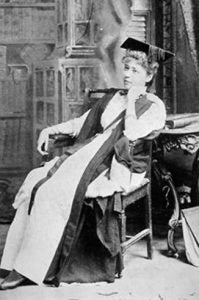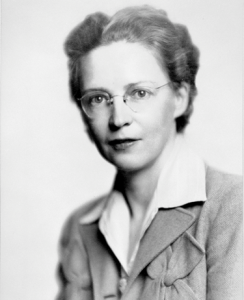
 Elsie MacGill was born in 1905 in Vancouver, British Columbia. She was the second daughter of Helen Gregory MacGill (1864–1947) and James Henry MacGill (1869–1939).
Elsie MacGill was born in 1905 in Vancouver, British Columbia. She was the second daughter of Helen Gregory MacGill (1864–1947) and James Henry MacGill (1869–1939).
At age 19, Helen Gregory moved to Toronto with the dream of becoming a concert pianist. She became the first woman to graduate from Trinity College (now the University of Toronto) and was the first woman in the British Empire to earn a degree in music. She went on to earn a Bachelor of Arts and, in 1890, a Master of Arts degree.
After her first husband died, she worked as a journalist to s upport her two young sons. The following year, she married former classmate James Henry MacGill. He was a journalist, lawyer and deacon of the Church of England. Helen Gregory MacGill also taught herself law. In 1917, she became the first woman judge appointed in British Columbia.
In 1911, Gregory (now MacGill) led an initiative whereby 12 women’s organizations purchased a large building on Thurlow Street, designated the Vancouver Women’s Building. It served as the first centre of its kind in Canada, providing office and meeting space for women’s groups and dime-a-day childcare. MacGill taught classes there on writing, public speaking and how to conduct and effectively participate in meetings.
MacGill was at the forefront of the fight in British Columbia, which granted women the right to vote in 1917, the same year she became a judge. The action allowed women not only to vote but also to run for and be appointed to public office.
MacGill’s widening circle of friends included painter Emily Carr, who provided young Elsie with art lessons. Another was feminist and social advocate Nelly McClung.
Elsie MacGill attended public school as a child. She then enrolled in applied science at the University of British Columbia in 1921. She finished her first two years of that program. In 1923, MacGill enrolled at the University of Toronto’s School of Practical Science in electrical engineering. This was a bold move, as she was the first woman admitted to the engineering program. Not surprising considering who her mother was and the fact that her maternal grandmother, Emma Gregory, was also a suffragette.
In 1929, she completed her master’s degree in aeronautical engineering. This was a groundbreaking step for women. It effectively made MacGill the first woman aeronautical engineer in the world. However, MacGill’s celebration was cut short when she was diagnosed with polio in 1929.
After her temporary confinement to a wheelchair, MacGill spent time recovering at home in Vancouver. In addition to her physiotherapy regimen, she drafted aircraft designs and wrote articles on aviation for popular publications like Chatelaine. She also participated in some of her mother’s feminist activities. The Canadian Federation of Business and Professional Women’s Clubs was among the feminist causes she joined during this period.
In 1938, two important events occurred in MacGill’s career. First, she took a job as chief aeronautical engineer at Canadian Car & Foundry (Can Car) in Fort William (now Thunder Bay), Ontario. Second, the Engineering Institute of Canada accepted her application for membership. This made her the first woman member of the professional association.
Upon her arrival at Canadian Car & Foundry (Can Car), MacGill undertook many projects. One of these projects was the design, construction and testing of the Maple Leaf II Trainer. While the plane was based on a previous model, MacGill completely re-engineered it and did so at impressive speed. She saw the prototype through to aerial testing very early in her tenure at Can Car. The plane never went into full production in Canada. However, it is recognized as the first aircraft designed and produced by a woman.
After this achievement, MacGill oversaw the retooling of the Can Car plant. She equipped it to mass-produce the Hawker Hurricane. The Hurricane was one of the main fighters flown by Canadian and Allied airmen in the Battle of Britain.
In 1942, the American True Comics series dubbed her “Queen of the Hurricanes” in a story they ran about her.
As a liberal feminist, Elsie MacGill believed in change via the reform of existing laws and policies. She also had some radical ideas for the time. For instance, MacGill believed that women should have full control over their own bodies. She therefore considered the issue of abortion a private matter between a woman and her doctor. (At the time, abortion was illegal under the Canadian Criminal Code. It was decriminalized in 1988.)
After her mother died in 1947, MacGill was determined to capture Helen Gregory MacGill’s important achievements. She published My Mother the Judge: A Biography of Helen Gregory MacGill in 1955. This project served to reignite MacGill’s feminist activism. She championed women’s role in society. In particular, she advocated that Canada would improve with the proper consideration and use of “womanpower.”
From 1967 to 1970, MacGill served on the Royal Commission on the Status of Women in Canada. Her co-commissioners acknowledged her as the leading feminist among them. For the rest of her life, MacGill worked to see as many of the report’s 167 recommendations implemented as possible.
MacGill rejected the label “woman engineer.” Her perspective was that she was an engineer, period. The fact that she was a woman did not need to be highlighted. After all, she had proven time and again that her sex in no way impacted her ability to do her job.
On 4 November 1980, MacGill died while visiting her sister, Helen MacGill Hughes, in Cambridge, Massachusetts. Her loss was a shock to all who knew her. At 75 years of age, MacGill had remained active in her career. The previous year, she had received the Association of Professional Engineers Ontario’s highest honour – the Gold Medal. Her continued feminist activism had included support for the UN’s International Women’s Year in 1975 via the CFBPWC. Among other activities, she had been a member of the Advisory Committee for the International Year of Disabled Persons, which was planned for 1981.
